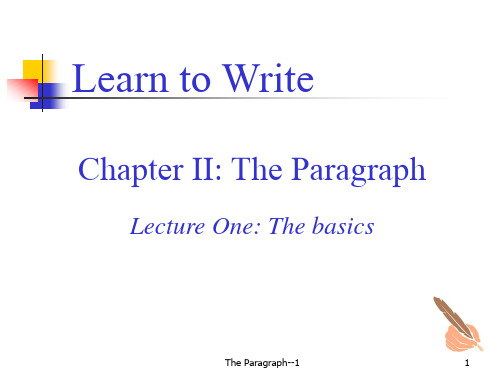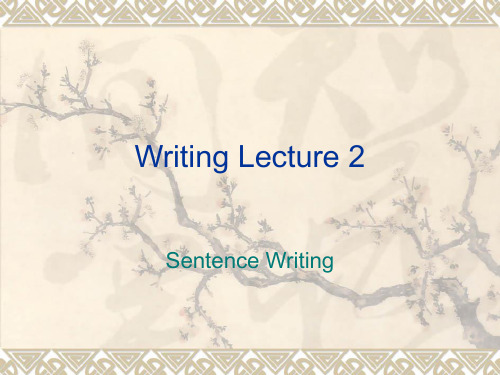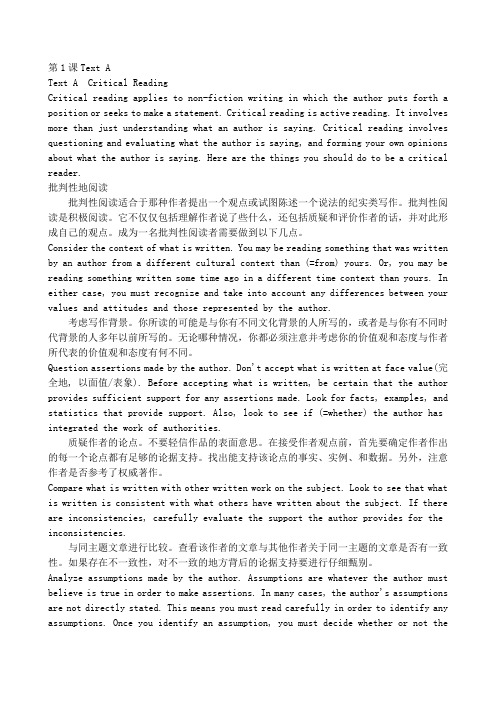Chapter I-Lecture 2(The Sentence--Common errors)1.3
- 格式:ppt
- 大小:218.50 KB
- 文档页数:23

Another School Year – What for?John CiardiText AppreciationI.Text Analysis1.Theme2.Structure3.DiscussionII.Writing Devicesnguage Style & Tone2.MetaphorIII.Sentence ParaphraseText AnalysisThemeThe author tries to clarify the purpose of a university: to put the students in touch with the best civilization that human race has created.StructurePart 1 (Paras. 1—8 Part 2 (Paras.9—14):The writer describes hisencounter with one of hisstudents.):The author restates what he still believes to be the purpose of a university: putting its students in touch with the best civilizations the human race has created.Text AnalysisSentence Paraphrase•Let me tell you one of the earliest disasters in my career as a teacher.(Para. 1)•Let me tell you something that happened when I first became a teacher. It was one of the exasperating experiences in the first days of my teaching career.•The word “disaster” often means “an unexpected event, such as a very bad accident, a flood or a fire that kills a lot of people or causes a lot of damage”. Here, used informally, it means "a complete failure". The writer exaggerates the situation and uses the word humorously.Sentence Paraphrase… I was fresh out of graduate school starting my first semester at the University of Kansas City. (Para. 1)to have just come from aparticular place, to havejust had a particularexperience, e.g. studentsfresh from college… I had just completed my graduate studies and began teaching at the University of Kansas City.•Part of the student body was a beanpole with hair on top who came into my class, sat down, folded his arms, and looked at me as if to say "All right, teach me something.” (Para.1)•The sentence tells us what an unfavorable impression the student left on the writer the first day he came to class. First, he was referred to as “a beanpole with hair on top” (顶上长了毛、种豆角时用的长竿).Also, his manners irritated the writer: instead of listening attentively and taking notes, he behaved as if he had paid to watch a show of some sort and was waiting to be entertained.•The word "beanpole“ means "a tall thin person",Here the writer deliberately evokes a "bean pole”, a pole farmers use as a support in growing beans.••part of the student body: one of the students•the student body: all the students of the university•body: a group of people who work or act together, often for an official purpose, or who are connected in some other way, e. g.– a law-making body 工法机构–the governing body of the university 大学管理机构Sentence Paraphrase•Two weeks later we started Hamlet.(Para.1)•Obviously, the writer was teaching a course on Shakespeare. In such a course, generally five of Shakespeare's plays are studied. Hamlet generally included.Sentence Paraphrase•Three weeks later he came into my office with his hands on his hips. “Look,” he said, "I came here to be a pharmacist. Why do I have to read this stuff?“ (1)•with his hands on his hips: This shows that the student wasn‘t carrying anything, and what’s more, this business-minded young man came to challenge his instructor, like a customer questioning the goods or service they have bought.Sentence Paraphrase•New as I was to the faculty, I could have told this specimen a number of things·(2)•Though I was a new teacher, I knew I could tell him what "university w as for. But I didn't. (我虽然经验不多) 也讲得出这些道埋(但我没有讲)。




新托福强化听力讲义新托福考试听力部分介绍1.新托福和旧托福的对比考试形式预读题目笔记题型PBT旧托福Paper Yes No 1/4 multiple choiceIBT新托福Internet No Yes New types2.题量,时间,分数文章类型题量题目数时间CONVERSATION 2-3 5 / conversation 2-3 min /conversation LECTURE 4-6 6 / lecture 4-6 min / lecture TOTAL 6-9(加试)34 60-90 min SCALE SCORE: 30 见OG185评分标准3.题目的考查形式➢考场环境:独立电脑,耳机,铅笔,草稿本➢电脑环境:图片,视频,声音,板书➢新题型:双选题,重听题,表格配对题➢答题时间:总时间限制,每题分配时间不限➢答题流程:永不悔改4.文章材料的考查形式➢文章结构:删除了旧托福的PART A 部分,更加注重于对于能力的考查➢文章长度:比旧托福长➢文章语速:无所谓快慢,比旧托福更加贴近真实的学习生活➢文章类型:对话,独白,讨论CONVERSATION文章思路LECTURE文章思路5.新托福考试题型概述IBT listening comprehensionBasiccomprehensionGist questionDetail questionPragmaticunderstandingPurpose questionAttitude questionConnectinginformationOrganization questionInference question题号问题题型1Why does the student go to see theprofessor?Gist question2 According to the professor, whatinformation should the student include inher statement of purpose?Detail Question3What does the professor consider unusualabout the student’s background?Detail Question 4 Why does the professor tell a story about Detail Questionhis friend who went ot medical school?5 What does the professor imply about thepeople who admit students to graduateschool?Inference question6 What are the students mainly discussing? Gist question7 Listen again and then answer thequestion:Why does the woman say this?Purpose question8 According to the conversation, why aretransposes sometimes called “jumpinggenes”?Detail Question9 According to the conversation, what are twoways in which bacteria cells get resistancegenes?Detail Question10What can be inferred about the resistancegenes discussed in the conversation?Inference question11 What is the talk mainly about? Gist question12What is the professor’s point of viewconcerning the method of “safe yield”?Detail Question 13 According to the professor, what are two Detail Questionproblems associated with removing wter from an underground system?14 Listen again and then answer thequestion:Why does the professor say this?Purpose question15What is a key feature of a sustainable watersystem?Detail Question16 What does the professor imply about watersystems managed by the “safe yield”method?Inference question17Why does the professor talk about Plato’sdescription of society?Gist question18 Listen again and then answer thequestion:Why does the professor imply aboutplato’s ethical theory?Attitude question19 Listen again and then answer thequestion:Why does the professor ask this?Purpose question20 What are two points that reflect Plato’s Detail Questionviews about education?21 Based on information in the lecture, indicatewhether the statements below abouthuman emotion reflect beliefs held by Plato,Organizationquestion22According to Plato, what is the maincharacteristic of a good or just person?Detail Question23 What is the main topic of the lecture? Gist question24According to the professor, why did onescientist grow a rye plant in water?Detail Question25 Listen again and then answer thequestion:Why does the professor say this?Purpose question26 The professor mentions houseplants thatreceive too much water. Why does shemention them?Detail Question27 Listen again and then answer thequestion:Why does the professor intend to explain?Purpose question28According to the professor, what similarity isthere between crabgrass and rye plants?Detail Question29 What is the lecture mainly about? Gist question30 Why does the professor talk about aconstruction company that has work indifferent cities?Detail Question31 Listen again and then answer thequestion:Why does the professor say this?Purpose question32What is an example of a violation of the“unity of command” principle?Detail Question33 According to the professor, where mightthere be a conflict in an organizationalstructure based on both projects andfunction?Detail Question34 Indicate whether each sentence belowdescribes functional organization or project organization. Place a check mark in thecorrect box.Organizationquestion➢Gist question: 6➢Detail question: 16➢Purpose question: 6➢Attitude question: 1➢Organization question: 2➢Inference question: 3 6.界面展示7.IBT新托福资料说明——听力部分图片资料名称特点推荐使用方法The Official Study Guide ●题目数量不多●难度较简单●题型全面,和考试相同,质量高●精听精做●题目分类研究●文章精读研究●不建议模考ETS TOEFL PRACTICE ONLINE ●一共14套,其中新东方引进4套,还有2套是OG题目,其他全部为全真试题●难度和考试相当,已经有较全的版本出现●题型全面,场景全面●精听精做●建议最后冲刺模考DELTA 新托福考试备考策略与模拟试题●题目数量大,后面有四套模拟试题●前面的训练题目文章较短,不是托福模拟●精听精做●建议考前强化训练●对语速跟读●听力材料要比考试稍难些,速度也稍快些●题型和考试相差很多,不建议细钻模仿DELTA 新托福考试模拟试题●题目数量大,有六套模拟试题●具体特点同蓝皮delta●建议考前模拟●对语速跟读模仿BARRON 新托福考试全真模考题与精解●题目数量大,后面有7套模拟试题●难度偏小,在基础班使用●建议平时精听训练KAPLAN模考试题四套●有四套模拟试题●听力部分略难,语速略快●配合模拟光盘,有临考感觉●考前模考THOMSON模考试题两套●只有两套题,但质量很好,文章难度适中,题目难度和Barron相近,感觉上略难一些,和考试非●建议模考常相似。

第1课Text AText A Critical ReadingCritical reading applies to non-fiction writing in which the author puts forth a position or seeks to make a statement. Critical reading is active reading. It involves more than just understanding what an author is saying. Critical reading involves questioning and evaluating what the author is saying, and forming your own opinions about what the author is saying. Here are the things you should do to be a critical reader.批判性地阅读批判性阅读适合于那种作者提出一个观点或试图陈述一个说法的纪实类写作。
批判性阅读是积极阅读。
它不仅仅包括理解作者说了些什么,还包括质疑和评价作者的话,并对此形成自己的观点。
成为一名批判性阅读者需要做到以下几点。
Consider the context of what is written. You may be reading something that was written by an author from a different cultural context than (=from) yours. Or, you may be reading something written some time ago in a different time context than yours. In either case, you must recognize and take into account any differences between your values and attitudes and those represented by the author.考虑写作背景。
Lecture2中英文字幕Unit6 Go shoppingLecture2 Sales and promotionHello, everybody.大家好In this session we are going to focus on the main idea and structure of our text on p.78.这节课我们主要来讲解一下78页课文的大意及文章结构。
Do you know how to find out the main idea of an article?你们知道如何找出文章的大意么?Let’s watch a video clip to figure it out.让我们来看一段视频短片What have you learnt from the video clip?从这段视频中你们学到了什么?To find out the main idea, we should try to find the topic.想找出文章的大意我们应该先找到文章的主题Repeating words in the text can help us to find the topic.文章中重复出现的词有助于我们找出文章的主题Look! What are the repeating words in our text?看!这篇课文中重复出现的词是什么?As we can see technique and response are repeated many times in the text.正如我们所看到的,technique和response是课文中重复出现的词。
Response means the way to resist the techniques ,response在这篇文章中的意思是应对促销手段的方法so the main idea of the text is sales techniques and the ways to resist the techniques.所以这篇文章的大意就是促销手段和应对方法A sales technique is a selling method that is used by a sales person or sales team to make money and help sell more effectively.促销手段是销售人员或销售团队为了赚钱或卖出更多商品而采取的销售策略The way to resist the techniques means the way to fight against the sales techniques.应对方法是指应对这些促销手段的方法。
Week Two MorphologyLecture OneHow is it that we can use and understand words in our languages that we have never encountered before? This is the central question of morphology, the component of a grammar that deals with the internal structure of words. Have you ever met the two italicized words in following sentences? But I am sure you will understand their meaning effortlessly as long as you have studied English for certain years.Eg1. Many mental patients were released because of a policy of deinstitutionalization.An expert advocate re-institutionalization as the only source for many of these people.Why do we know this? We know this because we know what the word institution means and we have acquired knowledge of English morphology.Morphology deals with the internal structure of complex words. The words of any language can be divided into two broad categories, closed and open2, of which only the latter are relevant to morphology. The closed categories are the function words: pronouns like you and she; conjunctions like and, if, and because; determiners like a and the; and a few others. Newly coined or borrowed words cannot be added to these categories, which is why we say that they are closed. The categories of words that are open are the major lexical categories: noun (N), verb (V), adjective (Adj), and adverb (Adv). It is to these categories that new words may be added. Because the major problem of morphology is how people make up and understand words that they have never encountered before, morphology is concerned only with major lexical categories.1可以考虑加入汉语形态的相关例子。